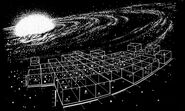AT: "xx" The Vulcan system was a star system in the Alpha Quadrant containing the planets Delta Vega and Vulcan, homeworld of the Vulcans, amongst others. Neighbouring the Andorian system it was located 16 light years from the Sol system. (ENT: "The Andorian Incident", "Home"; Star Trek)
The location of the Vulcan system in the Milky Way Galaxy was depicted on a Federation star chart in 2293. (Star Trek VI: The Undiscovered Country, production art)
The Vulcan sun was so bright, as seen from the planet Vulcan, that it caused the evolution of the Vulcan inner eyelid. (ENT: "The Forge"; TOS: "Operation -- Annihilate!")
In 2258, in the alternate reality, Delta Vega was the location of a Starfleet outpost. That year, Nero destroyed the planet Vulcan, leaving a small black hole in its place. (Star Trek)
Appendices
Related topics
Appearances
Background information

T'Khut and its moon seen from the surface of Vulcan

Two other worlds in the Vulcan system seen from the surface of Vulcan
In the "The Explored Galaxy" star chart, Vulcan was located between the Tholian Assembly and Romulus. Both locations were identified in DS9: "Call to Arms" as being located in the Alpha Quadrant.
The original theatrical edit of Star Trek: The Motion Picture depicted four large orbs in the Vulcan sky. They were removed in the DVD release of the director's edition of The Motion Picture and replaced by an orange sky. According to Star Trek: Communicator (issue 136, p. 27), the additional planets were removed for the reason that the scene took place during daytime, so a night sky was not appropriate, and they were elements that distracted the viewer from a scene intended to take place on a far-off monastic temple. Vulcan in and of itself was considered to be interesting enough without cluttering the sky with these planets.
According to Star Trek: Star Charts (pg. 58), T'Khut was the name of the Vulcans twin planet that was visible from the planets surface. T'Khut was classified as a G-class world, and had one moon. The Vulcan system also known as the 40 Eridani A System or Omicron2 Ceti System was a trinary star system. 40 Eridani A had a spectral type of K1V with an absolute magnitude of 6.0. 40 Eridani B had a spectral type of AVII with an absolute magnitude of 11.2. 40 Eridani C had a spectral type of M4V with an absolute magnitude of 12.3. The distance between A and B was 400 AU; distance between B and C was 44 AU. The orbital period of this system was 248 years.
There has been however no direct canonical reference of the Vulcan system being the 40 Eridani A system, although that is widely considered to be the case. In "Home" and "Daedalus", Vulcan was mentioned as being slightly over sixteen light years from Earth, the same distance between Earth and 40 Eridani A. According to text commentary by Michael and Denise Okuda for "The Forge" on the ENT Season 4 DVD, the possibility of Vulcan being located in the 40 Eridani system originated from a suggestion by novelist James Blish. When three astronomers (Sallie Baliunas, Robert Donahue, and George Nassiopoulas) who had been studying the system at Mount Wilson Observatory published a letter, stating that the star "40 Eridani A could support a planet with Earth-like life" and that it would "have the Sun's brightness for a planet 50 million miles away", they theorized that Vulcan could be in orbit of this star, a theory Gene Roddenberry himself supported by signing their letter, according to Sky & Telescope, 1991 July.
Recent real world discoveries have confirmed the likely presence of at least three planets in the Epsilon Eridanii system. [1]
External links
- 40 Eridani at Wikipedia
- 40 Eridani at the Internet Stellar Database
- Template:NCwiki



